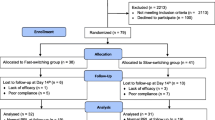Abstract
Remitted schizophrenic outpatients were treated in order to prevent relapse with three doses of haloperidol or propericiazine for 1 year in a double-blind controlled study employing a randomized design. The drug's ability to prevent relapse was evaluated by counting the number of symptom-free days for each patient before any sign of relapse or over-dose appeared. Patients were randomly assinged to the following drugs orally administered once per day at night: placebo; haloperidol 1 mg, 3 mg, and 6 mg; propericiazine 10 mg, 30 mg, and 60 mg. Serum prolactin levels in each patient were estimated by radioimmunoassay. All patients treated with placebo relapsed within 1 year and the relapse rate with placebo was significantly higher than with any dose of the two neuroleptics. Haloperidol increased the number of symptom-free days in a dose-dependent manner. Propericiazine at 10 mg and 30 mg also increased the number of symptom-free days dose-dependently but at 60 mg, the number decreased. It appears that propericiazine shows an inverted U-shaped dose-response curve. Prolactin levels were elevated dose-dependently by both drugs but failed to show a significant correlation with the number of symptom-free days. The present results indicate that haloperidol is superior to propericiazine from the viewpoint of the wider “therapeutic window” in maintenance treatment and antidopaminergic properties of neuroleptics, wherein it is important to prevent relapse even in remitted schizophrenics.
Similar content being viewed by others
References
Andén N-E, Butcher SG, Corrodi H, Fuxe K, Ungerstedt U (1970) Receptor activity and turnover of dopamine and noradrenaline after neuroleptics. Eur J Pharmacol 11:303–314
Cheung HK (1981) Schizophrenics fully remitted on neuroleptics for 3–5 years. —To stop or continue drugs? Brit J Psychiatry 138:490–494
Crow TJ, Johnstone EC, Longden AJ, Owen F (1978) Dopaminergic mechanisms in schizophrenia: The antipsychotic effect and the disease process. Life Sci 23:563–567
Davis JM (1975) Overview: Maintenance therapy in psychiatry. I. Schizophrenia. Am J Psychiatry 132:1237–1245
Davis JM, Erickson S, Dekirmenjian H (1978) Plasma levels of antipsychotic drugs and clinical response. In: Lipton MA, DiMascio A, Killam KF (eds) Psychopharmacology: A generation of progress. Raven Press, New York, p 905
Engelhart DM, Rosen B, Freedman N, Margolis R (1967) Phenothiazines in prevention of psychiatric hospitalization. IV. Delay or prevention of hospitalization —A reevaluation. Arch Gen Psychiatry 16:98–101
Hartmann E (1976) Schizophrenia: A theory. Psychopharmacology 49:1–15
Hirsch SR, Gaind R, Rohde PD, Stevens BC, Wing JK (1973) Outpatient maintenance of chronic schizophrenic patients with long-acting fluphenazine: Double-blind placebo trial. Br Med J 1:633–637
Kane JM, Rifkin A, Woerner M, Reardon G (1982) Low-dose neuroleptics in outpatient schizophrenics. Psychopharmacol Bull 18:20–21
Klawans HL, Margolin DI (1975) Amphetamine-induced dopaminergic hypersensitivity in guinea pigs: Implications in psychosis and human movement disorders. Arch Gen Psychiatry 32:725–732
Kuribara H, Tadokoro S (1981) Correlation between antiavoidance activities of antipsychotic drugs in rats and daily clinical doses. Pharmacol Biochem Behav 14:181–192
Leff JP, Wing JK (1971) Trial of maintenance therapy in schizophrenia. Br Med J 3:559–604
Meltzer HY, Busch DA, Fang VS (1981) Effect of neuroleptics on serum prolactin levels in relation to clinical response and neuroleptic blood levels. In: Usdin E (ed) Clinical pharmacology in psychiatry. Elsevier, New York, p 251
Nishikawa T, Tsuda A, Tanaka M, Koga I, Uchida Y (1982) Prophylactic effect of neuroleptics in symtom-free schizophrenics. Psychopharmacology 77:301–304
Praag HM van, Korf J (1975) Biochemical research into psychosis. Acta Psychiatr Scand 51:268–284
Snyder SH, Banerjee SP, Yamamura HJ, Greenberg D (1974) Drugs, neurotransmitters, and schizophrenia. Science 184:1243–1253
Stein L, Wise CD (1971) Possible etiology of schizophrenia: Progressive damage to the noradrenergic reward system by 6-hydroxydopamine. Science 171:1032–1036
Troshinsky CH, Aaronson HG, Stone RK (1962) Maintenance phenothiazines in aftercare of schizophrenic patients. PA Psychiatr Q 2:11–15
Uchida Y, Tsuda A, Koga I, Nishikawa T (1983) A trial on follow-up in outpatients with psychosis using the computer system —Analysis of social adjustment levels and regularity of consultation and/or prescription. Seishin Igaku (Clinical Psychiatry) 25:477–484
Author information
Authors and Affiliations
Rights and permissions
About this article
Cite this article
Nishikawa, T., Tsuda, A., Tanaka, M. et al. Prophylactic effect of neuroleptics in symptom-free schizophrenics: A comparative dose-response study of haloperidol and propericiazine. Psychopharmacology 82, 153–156 (1984). https://doi.org/10.1007/BF00427763
Received:
Accepted:
Issue Date:
DOI: https://doi.org/10.1007/BF00427763




